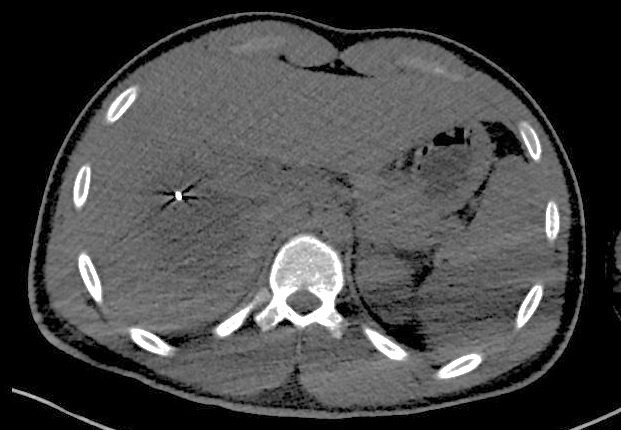Teen presents with cough and right upper quadrant pain

A previously healthy 17-year-old male is brought to your office with fever, cough and right upper quadrant pain with periodic nausea, vomiting and diarrhea.
The history of this illness revealed a gradual onset of the symptoms beginning about 2 weeks earlier. His past medical history is positive for being born and raised in central Mexico before moving to the Southern United States when he was 13 years of age. However, he returned to his hometown in Mexico to visit relatives recently, where he spent 2 weeks before returning to the U.S. 2 months ago.
Examination revealed a fever of 102.7°F, mild weight loss and right upper quadrant (RUQ) pain on palpation. Lab results available include a normal CBC, mild elevation of liver enzymes, a C-reactive protein (CRP) level of 214 and a negative Echinococcus antibody test that was sent to the CDC earlier because of the imaging shown here. A stool pathogen panel is pending, and a CT scan of the abdomen shows a large cystic lesion in the liver (Figures 1 to 3).



Summary:
- The patient is a previously healthy 17-year-old male.
- He spent extensive time in central Mexico.
- Symptoms include fever, cough and RUQ abdominal pain and periodic nausea, vomiting and diarrhea.
- Lab results were unremarkable except for a CRP of 214, and the patient has a negative Echinococcus antibody test.
- Imaging shows a large cystic lesion in the liver.
What’s your diagnosis?
A. Toxocariasis
B. Amebiasis
C. Hydatid cyst
D. Pyogenic liver abscess


The answer is B, amebiasis. This is a fairly typical story for extraintestinal amebiasis, with strongly supporting lab and imaging results. This process begins by ingesting mature cysts that transform into trophozoites in the small intestine, and they migrate to the large intestine, as shown in this life cycle illustration from the CDC. There, the trophozoites may remain in asymptomatic carriers, or cause colitis or penetrate through the mucosa and spread, usually to the liver. The diagnosis may be suspected with a positive stool PCR panel for Entamoeba histolytica, which this patient had. However, the false-positive rate is such that a confirmatory microscopic exam may be needed. This patient also had a positive antibody test for E. histolytica. Treatment of a large amoebic liver abscess is best managed by needle aspiration via interventional radiology (Figure 4), combined with medical therapy with a combination of metronidazole for 10 days, followed by an intraluminal amebicide, such as paromomycin for 7 days, and follow-up documentation of clearance by repeat stool analysis. This case showed no evidence of disease at the 1-year follow-up (Figure 5).
Before aspirating the abscess, it is advisable to rule out echinococcosis with a hydatid cyst. In this case, the lesion appeared to be a solitary cystic lesion on CT imaging, rather than a multicystic lesion, characteristic of a hydatid cyst. Additionally, the patient had a negative Echinococcus antibody test from the CDC, so the odds of echinococcosis occurring with a solitary cyst and a negative Echinococcus antibody test along with a positive stool and antibody test for amebiasis would seem very low.

A case of visceral larva migrans (toxocariasis) can be reviewed in the May 2020 column. The liver lesions are small and hypoechogenic, as seen in Figure 6 — not cystic. Lastly, a pyogenic liver abscess may look similar but is very rare in otherwise healthy children. Additionally, I would expect the child to be sicker with such a large collection of pus.
Columnist Comments
You may have noted that I have been fairly quiet on the COVID-19 pandemic so far. It’s not that I am uninterested but rather somewhat burned out on it. We are swamped with information on the topic and can hardly turn a journal page or a television channel without learning the latest, over and over again. It’s hard to not become a bit cavalier about it after this long. Additionally, I would rather feature cases and subjects in this column that offer a little more diagnostic challenge, such as this one. Don’t get me wrong, this pandemic is likely to go down as the sentinel event of any infectious diseases specialist’s career but only because of its magnitude, not the diagnostic challenge. Infectious diseases specialists are inherently diagnosticians — medical detectives, if you will — often being called upon to sort out a confusing clinical picture. It’s the thrill of clinical discovery or diagnosis that drives many of us; it’s certainly not the money. In my experience, a significant proportion of consults are performed on patients without an infectious disease at all. Sometimes, those are the most gratifying.
One of my greatest clinical moments was when I diagnosed a 17-year-old male with Addison disease (that’s right, Addison, not Addison’s), who was sent to me because of chronic fatigue and just not feeling well for over a month. In Texas, many people have dark skin, but there was something unusual about his skin tone. I asked him to remove his shirt and raise his arms; he was “tan all over” with no history of “tanning.” After some quick blood tests revealing low sodium and high potassium and a same-day consult in the endocrine clinic, the month-long mystery was solved. My only regret was that I did not get pictures of him.
This reminds me that as I get older and see fewer patients, my clinical pickings (cases and photographs) are getting slim. If anyone out there has a publication-quality picture(s), with permission to use, and you would like to be a guest columnist, just let me know, and I will help make it happen. Now back to COVID-19!
For more information:
Brien is a member of the Infectious Diseases in Children and Infectious Disease News Editorial Boards, and an adjunct professor of pediatric infectious diseases at McLane Children's Hospital, Baylor Scott & White Health, in Temple, Texas. He can be reached at jhbrien@aol.com.
